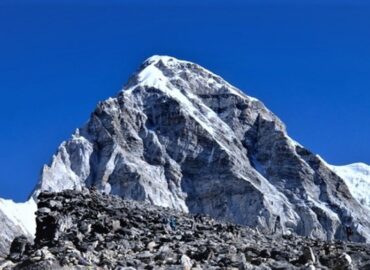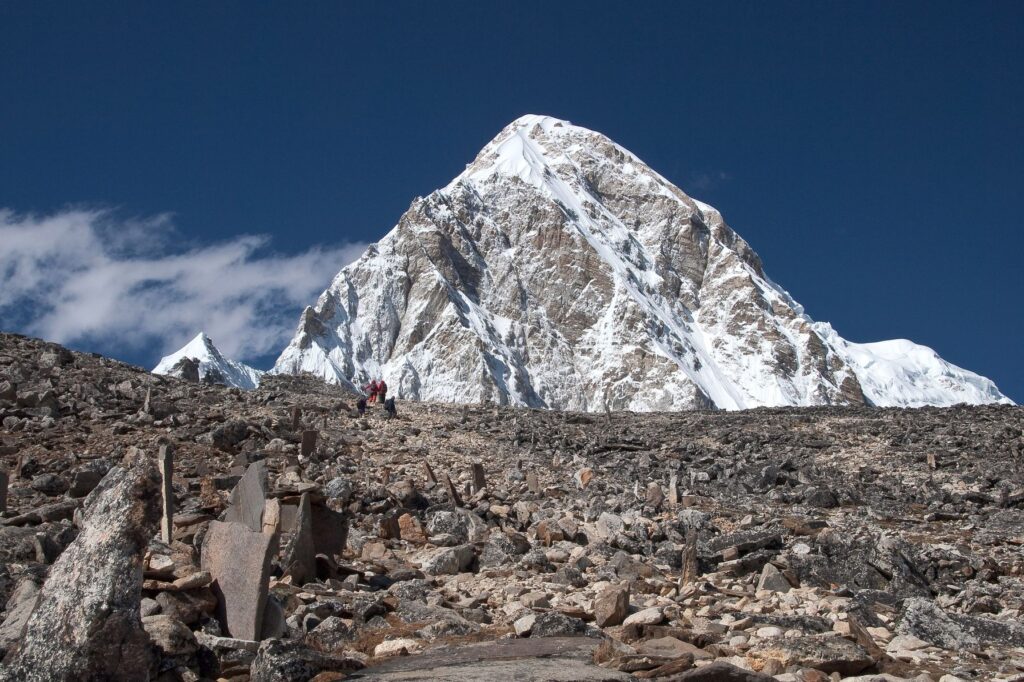- info@destinationholidaytrek.com
- +977-9768913779
- Gokarneshwor-6, Arubari, Kathmandu, Nepal
Pumori Expedition (7,161m)
| Destination: | Nepal |
| Maximum Altitude: | 7,161 meters |
| Best Season: | Spring & Winter |
| Trip Grade: | Extreme Hard |
| Group Size: | 1 – 15 people |
| Duration: | 36 Days |
Pumori Expedition Overview
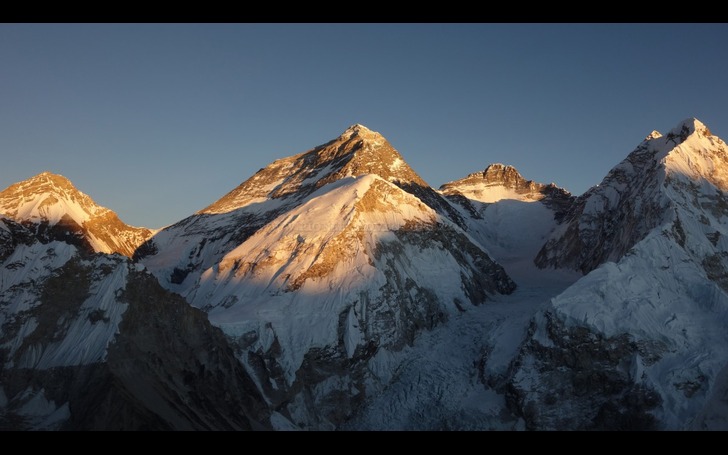
Mount Pumori (7,161m/27,494ft) is one of the most challenging 7,000-meter peaks in Nepal’s Himalayas. Known as “Unmarried Daughters” in Sherpa language, Pumori has been a magnet for climbers, both novice and experienced, for many years. This beautiful peak is located on the Nepal-China border in the Mahalangur Parbat range, just 8.5 kilometers west of Mount Everest and 4.5 kilometers from Nuptse.
Pumori stands as one of the most stunning and accessible peaks in the region. Below it, Kala Patthar (5,643m/18,513ft) provides one of the best vantage points for viewing its magnificent south face. The trek to Base Camp is fascinating and offers a seamless transition to the more strenuous climbing ahead.
The mountain is part of the Khumbu-Himal Range and lies at the Chomolungma mountain junction. The Western Rongbuk and Khumbu glaciers surround the ridge from the south and north. Pumori was first seen by the British reconnaissance expedition in 1921, along with Lingtren and Nuptse.
Though multiple routes lead to the summit, the classic one ascends along the southeast buttress and then traverses the East Ridge for the final approach. The summit’s coordinates are recorded by the Nepalese government as 28°00’53” N and 86°49’41” E.
Due to its high-altitude location, the terrain around Pumori is devoid of vegetation, consisting mainly of rocks and moraine deposits from the glaciers. From the summit, climbers can marvel at the incredible sight of four of the world’s eight-thousanders: Mount Everest, Lhotse, Makalu, Nuptse, and Cho-Oyu.
Climbing Pumori requires prior experience with 8,000-meter peaks or similar climbs, as well as strong physical conditioning. The ascent involves technical climbing with slopes ranging from 40 to 60 degrees. Climbers will be roped off and guided by experts along the route, with multiple camps set up at varying altitudes before the final summit push.
The best times to climb are in the spring and autumn. From Pumori’s summit, climbers enjoy magnificent views of Everest, Lhotse, and the Tibet’s Rongbuk Glacier. Pumori is perfect for climbers who are seeking a challenging 7,000-meter ascent in about a month. This expedition will test your endurance, technical abilities, and climbing skills, but the unparalleled views and sense of accomplishment at the top will make every step worthwhile.
Pumori Expedition Highlights
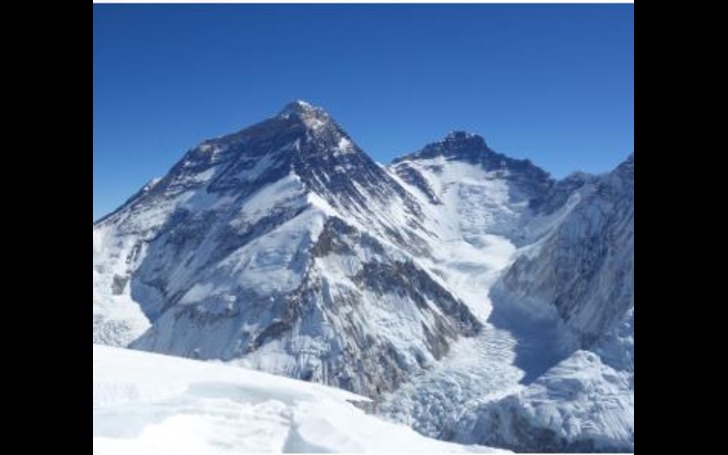
- Views of the Himalayas: Admire the breathtaking vistas of Mount Everest and surrounding peaks, including Lhotse, Nuptse, and Makalu, offering some of the best views in the world.
- Demanding Climbs: Conquer the steep glaciers, snow-covered slopes, and technical ascents, pushing your limits and gaining valuable high-altitude climbing experience.
- Local Sherpa Heritage: Immerse yourself in the rich culture and customs of the Sherpa people, experiencing their hospitality and gaining insight into their way of life.
- Sherpa Villages, Forests & Suspension Bridges: Trek through charming Sherpa villages, lush forests, and cross iconic suspension bridges, each offering a unique piece of the Himalayan experience.
- High Camps & Acclimatization: Establish high-altitude camps to aid acclimatization at increasing altitudes, ensuring a safe ascent while soaking in the stunning surroundings.
- Navigating the Khumbu Icefall: Conquer one of the most challenging parts of the journey—the treacherous Khumbu Icefall—while learning the skills required to navigate glaciers and crevasses safely.
- Acclimation Treks: Embark on picturesque hikes that help your body adjust to the increasing altitude, ensuring a successful climb and minimizing the risk of altitude sickness.
- Camp Life at High Altitudes: Experience life at base camps and higher altitudes, where the sense of camaraderie and the rugged mountain environment create an unforgettable adventure.
- Climbing Techniques: Improve your climbing skills in ice and mixed terrain, learning the techniques necessary to navigate crevasses, ascend steep faces, and use technical gear with precision.
- Peak Ascent Excitement: Feel the exhilaration and accomplishment of summiting one of the world’s most challenging peaks, taking in 360-degree views of the Himalayas.
- Flora and Fauna Exploration: Encounter diverse wildlife and unique flora, from Himalayan tahr and snow leopards to rare alpine plants, highlighting the region’s ecological richness.
- Everest Proximity: Get close-up views of Mount Everest, from unique vantage points rarely seen by the public, making this an unforgettable Everest experience.
- Monasteries & Himalayan Way of Life: Visit iconic monasteries along the trek, gaining a deeper understanding of the spiritual life of the region’s inhabitants, and experiencing the peaceful Himalayan way of life.
- Planning & Preparation: The climb requires careful planning, experienced guides, and the proper equipment to ensure a safe and successful expedition at high altitudes.
Pumori Expedition General Route Overview
From Gorakshep, we commence the climbing phase. Before we attempt the summit, we will ensure that everyone is fully prepared for the challenge. Each day, we will practice essential climbing techniques and take short climbs to higher altitudes, allowing you to gain confidence and test your skills. Your Sherpa Expedition & Trekking guide will meticulously check all equipment and ensure that each member is physically and mentally prepared for the summit attempt at Pumori (7,160m). We have planned additional days in case of unfavorable weather, which will be used to further acclimatize as we camp at various altitudes on the mountain, designated as base camps.
We will start the climb early to ensure plenty of time to reach the summit. The weather tends to be calmer and more predictable in the morning, but we must remember that nature follows its own rules.
We will ascend the southeast ridge, following the trail through the Khumbu region, passing through Phakding (2,652m), Namche Bazaar (3,440m), Everest View Hotel (3,800m), and Tyangboche (3,850m), where we will visit its famous Buddhist monastery. From there, we continue to Dingboche (4,350m), and then to Lobuche (5,018m), where we will take time to acclimatize, an essential process for ensuring your physical readiness for the summit of Mount Pumori. Our next stop is Gorakshep (5,170m), where the gradual ascent continues. It’s widely believed that an optimal daily elevation gain of 500 meters aids in proper acclimatization.
Base Camp sits at 5,300m (17,388ft). The next stage involves crossing icy terrain and sharp ridges for 4 to 5 hours before reaching Camp I at 5,700m (18,701ft). From Camp I, we will tackle a steep 40 to 60-degree snow-covered face to reach Camp II at 6,200m (20,341ft). Continuing from Camp II, we will cross more ice and chasms to reach Camp III at 6,500m (21,325ft), where we will prepare for the final push to the summit.
Destination holiday treks & expedition has all the necessary trainers. For more information please contact us:
The expedition permit cost to mount Pumori depends on the season you choose for your trek. Since the spring season is considered the peak and most favorable for the climb, the expedition permit fee set by the Nepal government is $500 per person. The trek in the autumn season will cost you little more than in the winter and summer.
The costs that you exclusively have to pay include Nepal tourist Visa cost, Kathmandu stay, your personal expenses, tips to porter and guide, and travel and medical insurance.
BEST SEASON FOR PUMORI EXPEDITION
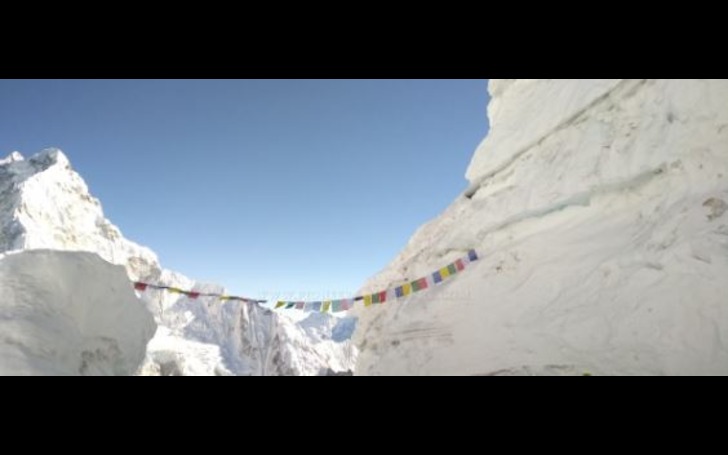
Although the Nepal government issues the climbing permit for all seasons the most favorable season for climbing Pumori and viewing it in all its glory would be the spring season, from April to May, as the temperature at the foot of Pumori does not exceed+18C in these months making your trek exemplary.
In the winter season, from late December to February the temperature in Pumori drops to 35c and lower depending on wind currents). However, the winter season is more favorable than the summer season (June to August). It will have a minimal risk of ice falls due to low temperatures and a long absence of snowfall during this period.
During the monsoon period (mid-may-September), climbing Pumori is unsuitable due to snowfalls and the avalanche danger. There will be a lot of snowfall around September, so avalanches may frequently occur day and night.
The other favorable time period to trek to Pumori is from the latter half of November to early December (autumn season). The season is marked by the stability of snow, calm wind, and moderate day time temperature.
HOW HARD IS PUMORI EXPEDITION TO CLIMB?
If you follow the classic route along the south-eastern ridge, your trek to Pumori will be relatively simple, easy, and less challenging. The technical difficulty is not high, and there’s less possibility of an avalanche. The other normal route that you can take is through the southern ridge. It is the second most climbed after the usual route, and although there is little danger of avalanches, there are many elements of rock climbing that require skill and power.
However, you shouldn’t underestimate the potential risk of high peak climbing such as Pumori. Skills of walking on difficult ice terrain, mastering the techniques of climbing along the railing, descending with a rappel, teamwork, physical and mental fitness, and periodic acclimatization are key to success at the summit.
Included
- Airport transportation as per your arrival date to join the Pumori
expedition - 3-star
category hotel accommodation in Kathmandu on B/B plan - Kathmandu to Lukla to Kathmandu airfare as per the expedition itinerary.
- Pumori
summiteers climbing Sherpa (01 Sherpa: 02 climber’s ratio) - Group
climbing gears like rope, ice bar, etc for the Pumori expedition. - Pumori
peak climbing permit and all government taxes. - National park and conservation area permit fee for the expedition.
- Full
board high altitude meal while trekking to base camp and climbing Pumori - Liaison officer with all his expenses while on the Pumori climbing
expedition. - Expedition Manager, Expedition cook, support crew and porters with their
types of equipment, daily wages, food, insurance, etc. - All
camping gear including base camp tents, dining tent with table and chair,
kitchen and toilet tent, etc - Mountain Hardware high altitude tents while climbing the Pumori expedition
- Emergency Oxygen with regulator and mask while on the Pumori expedition.
- EPI
gas and burner for the high climb. - Gamow
bag / Portable Altitude Chamber (PAC) All necessary climbing hardware group
equipment - Satellite Phone and Walkie-Talkie in case of emergency.
Excluded
- Medical and personal high-risk insurance
- Nepal
entry visa fees - The
main meal in Kathmandu - Personal equipment and climbing gears.
- International airfare and airport tax
- Climbing Bonus, tips and personal nature expenses.
- Applicable permit fees and custom charge for Sat phone, communication
equipment and commercial filming while on Pumori expedition.
Pumori Expedition Itinerary
Day 1: Arrival in Kathmandu
Drive to Hotel: 30 Minutes
Maximum Altitude: 1,350m
Upon landing at Tribhuvan International Airport, you will be welcomed by our representative holding a placard with your name. After a warm reception, you will be taken to your hotel in the city center, where assistance will be provided for a smooth check-in process. You may choose to relax for the rest of the day or take a short break before exploring Kathmandu.
For those interested and available, we will visit Boudhanath Stupa, the largest Buddhist pilgrimage site in Nepal. The peaceful surroundings immediately embrace visitors as devotees and travelers perform the sacred kora (circumambulation) around the stupa. A rooftop restaurant offers a perfect spot to watch the beautiful sunset while experiencing the calm atmosphere.
Next, a 15-minute drive will take us to Pashupatinath Temple, one of the four most significant Hindu sites worldwide. Situated on the banks of the holy Bagmati River, this temple is a major spiritual landmark. Here, you can witness the evening Aarti, a sacred Hindu ritual that begins around 7 PM. Additionally, the site provides a rare glimpse of traditional open-air cremation ceremonies held on the opposite bank.
Afterward, we return to the heart of Kathmandu, take a brief walk through the lively streets of Thamel, and finally drop you off at your hotel.
Meals: Welcome Dinner
Accommodation: Standard Hotel in Kathmandu
Day 2 & 3: Kathmandu Sightseeing & Expedition Preparation
Full Day
Maximum Altitude: 1,350m
These two days will be dedicated to exploring some of the UNESCO World Heritage Sites in the Kathmandu Valley. After enjoying a delicious breakfast, your guide will pick you up from your hotel for a full-day escorted tour. The itinerary covers the majority of the seven UNESCO-listed sites in the valley. If Boudhanath and Pashupatinath were already visited on the first day, we will focus on the remaining landmarks, including Kathmandu Durbar Square, Swayambhunath Temple, Patan Durbar Square, and Bhaktapur Durbar Square.
Swayambhunath, also known as the Monkey Temple, is one of the most prominent sites in the valley, situated atop a hill that offers panoramic views of Kathmandu. Located about four kilometers from Thamel, it is a revered Buddhist pilgrimage site that also holds significance for Hindus and people of other faiths.
Patan Durbar Square, located in the city of Lalitpur, is an extraordinary showcase of Nepalese craftsmanship. The palace complex, once home to the Malla kings, houses several historical and cultural landmarks, including Krishna Mandir, Keshav Narayan Chowk, Sundari Chowk, the Royal Palace, and the intricately designed Royal Bath. The area is filled with centuries-old monuments that reflect the rich medieval heritage of Nepal.
Bhaktapur Durbar Square, situated in Bhaktapur—often referred to as the “City of Devotees”—is one of the best-preserved cultural heritage sites in the valley. The impressive palace complex, temples, and monuments display remarkable artistry and architectural brilliance. Highlights of this site include the Golden Gate, 55-Window Palace, Nyatapola Temple, and several other historical structures.
Kathmandu Durbar Square, located at the heart of the city within walking distance of Thamel, is one of the most visited sites in the capital. As the third durbar square in the valley, it is a must-see for its historical significance and stunning Newari architecture. The area features several important landmarks, such as Kumari Ghar, Kasthamandap, Taleju Bhawani Mandap, Kaal Bhairav Mandap, and Hanuman Dhoka Museum.
In addition to sightseeing, all necessary paperwork and final preparations for the Pumori Expedition will be completed. You may also take a stroll through the traditional markets of Ason and Newroad to experience local market life. For those interested, a rickshaw ride through the bustling streets of Thamel offers a unique way to explore the area. Thamel is also a great place for last-minute shopping, with numerous stores offering trekking and expedition gear for purchase or rent.
Enjoy a relaxing dinner and get a good night’s rest before embarking on the expedition journey the following day.
Meal: Breakfast
Accommodation: Standard Hotel in Kathmandu
Day 2 & 3: Kathmandu Sightseeing & Expedition Preparation
Full Day
Maximum Altitude: 1,350m
These two days will be dedicated to exploring some of the UNESCO World Heritage Sites in the Kathmandu Valley. After enjoying a delicious breakfast, your guide will pick you up from your hotel for a full-day escorted tour. The itinerary covers the majority of the seven UNESCO-listed sites in the valley. If Boudhanath and Pashupatinath were already visited on the first day, we will focus on the remaining landmarks, including Kathmandu Durbar Square, Swayambhunath Temple, Patan Durbar Square, and Bhaktapur Durbar Square.
Swayambhunath, also known as the Monkey Temple, is one of the most prominent sites in the valley, situated atop a hill that offers panoramic views of Kathmandu. Located about four kilometers from Thamel, it is a revered Buddhist pilgrimage site that also holds significance for Hindus and people of other faiths.
Patan Durbar Square, located in the city of Lalitpur, is an extraordinary showcase of Nepalese craftsmanship. The palace complex, once home to the Malla kings, houses several historical and cultural landmarks, including Krishna Mandir, Keshav Narayan Chowk, Sundari Chowk, the Royal Palace, and the intricately designed Royal Bath. The area is filled with centuries-old monuments that reflect the rich medieval heritage of Nepal.
Bhaktapur Durbar Square, situated in Bhaktapur—often referred to as the “City of Devotees”—is one of the best-preserved cultural heritage sites in the valley. The impressive palace complex, temples, and monuments display remarkable artistry and architectural brilliance. Highlights of this site include the Golden Gate, 55-Window Palace, Nyatapola Temple, and several other historical structures.
Kathmandu Durbar Square, located at the heart of the city within walking distance of Thamel, is one of the most visited sites in the capital. As the third durbar square in the valley, it is a must-see for its historical significance and stunning Newari architecture. The area features several important landmarks, such as Kumari Ghar, Kasthamandap, Taleju Bhawani Mandap, Kaal Bhairav Mandap, and Hanuman Dhoka Museum.
In addition to sightseeing, all necessary paperwork and final preparations for the Pumori Expedition will be completed. You may also take a stroll through the traditional markets of Ason and Newroad to experience local market life. For those interested, a rickshaw ride through the bustling streets of Thamel offers a unique way to explore the area. Thamel is also a great place for last-minute shopping, with numerous stores offering trekking and expedition gear for purchase or rent.
Enjoy a relaxing dinner and get a good night’s rest before embarking on the expedition journey the following day.
Meal: Breakfast
Accommodation: Standard Hotel in Kathmandu
Day 4: Fly to Lukla & Trek to Phakding
30-Minute Flight & 3-Hour Walk
Maximum Altitude: 2,610m
The day begins with an early morning flight to Lukla, landing at Tenzing Norgay Airport, known as one of the most thrilling airstrips in the world. The Twin Otter aircraft offers a short yet exhilarating journey, providing breathtaking aerial views of Everest and the surrounding peaks. Lukla serves as the gateway to the Khumbu Region, marking the starting point of the trekking adventure.
Upon arrival, we will meet the entire expedition team and begin our trek towards Phakding, situated at an altitude of 2,610 meters. This picturesque village is located along the banks of the Dudh Koshi River, which flows through the heart of the Khumbu region. As a key stop along the trade route, Phakding is home to well-built lodges that offer a comfortable stay for trekkers.
Meal: Breakfast, Lunch & Dinner
Accommodation: Tea House
Day 5: Trek to Namche Bazaar
5 to 6 Hours Walk
Maximum Altitude: 3,440m
The journey continues as we follow the Dudh Koshi Valley upstream, surrounded by breathtaking landscapes. From the very start, the trek offers a glimpse of the incredible adventure ahead, leading towards Mount Pumori.
Throughout the day, we will cross and re-cross the fast-flowing Imja Khola using well-constructed suspension bridges. Much of the trek will follow the riverbanks, making for a relatively gentle walk on mostly flat terrain. However, the final stretch of the day involves a challenging ascent leading to Namche Bazaar, the vibrant Sherpa capital, situated at 3,440 meters.
Upon reaching Namche, we will check into a comfortable lodge where you can relax or explore the lively marketplace, which serves as the main trading hub of the Khumbu region.
Meal: Breakfast, Lunch & Dinner
Accommodation: Tea House
Day 6: Rest Day at Namche for Acclimatization
Full Day Exploration
Maximum Altitude: 3,440m
Acclimatization is essential for high-altitude journeys, so we will spend an extra day in Namche to adapt to the lower oxygen levels. This day will include a mix of hiking and relaxation, which helps the body adjust more efficiently to the increasing altitude.
After breakfast, we will hike up to Syangboche Hill, situated at 3,900 meters. From this vantage point, the breathtaking panorama of the Everest region unfolds, featuring Everest, Lhotse, Nuptse, Ama Dablam, Kusum Kanguru, Tawache, Kunde, and several other snow-covered peaks.
The journey continues with a visit to the traditional Sherpa village of Khumjung, where we can see the famous Hillary School. A short walk from here leads to Khunde village, home to the Khunde Monastery. This monastery offers deep insights into Sherpa culture and traditions, and within its walls, you can also view a sculpture of the legendary “Yeti,” a creature often spoken of in myths.
After soaking in the spectacular sights and cultural experiences, we will return to Namche for an overnight stay.
Meal: Breakfast, Lunch & Dinner
Accommodation: Tea House
Day 7: Trek to Tengboche
5 Hours Walk
Maximum Altitude: 3,867m
Today’s trek continues along the banks of the Imja Khola, leading towards Tengboche at an altitude of 3,867 meters. The journey begins with a steep ascent as we leave Namche Bazaar and join the main trail. Once this initial climb is behind us, the path becomes more gradual, making for a pleasant and scenic trek through the Himalayan landscape.
Upon arrival at Tengboche, the breathtaking surroundings make the effort worthwhile. This picturesque village sits on a ridge just below the striking north face of Kang Taiga. One of the most rewarding aspects of the trek is the uninterrupted view of Everest, visible from various points along the route.
After reaching Tengboche, we will settle into a lodge near the renowned Tengboche Monastery, the largest and most significant Buddhist monastery in the Khumbu region. The serene atmosphere and stunning mountain backdrop provide a perfect setting to rest and recharge for the journey ahead.
Meal: Breakfast, Lunch & Dinner
Accommodation: Tea House
Day 8: Trek to Dingboche
4 Hours Walk
Maximum Altitude: 4,410m
The journey continues with a determined ascent towards Dingboche, a seasonal settlement located at an altitude of 4,410 meters. Along the way, we pass through Pangboche, the highest permanent settlement in the valley, where traditional Sherpa culture thrives against a backdrop of towering peaks.
This section of the trek presents a greater challenge as the elevation gain is more significant compared to the previous days. However, the breathtaking scenery, with mountains surrounding the trail from all directions, makes every step rewarding.
Upon reaching Dingboche, we will settle into a comfortable lodge for the night, taking in the incredible views of the high-altitude landscape.
Meal: Breakfast, Lunch & Dinner
Accommodation: Tea House
Day 9: Acclimatization in Dingboche / Hike to Chhukung
Full Day
Maximum Altitude: 4,410m
To aid in acclimatization, we will gain some elevation today with a hike to Chhukung, located at 4,730 meters in the upper Imja Valley. The trail is steep and narrow, offering a rewarding challenge as we ascend toward this small settlement nestled beneath the towering south face of Lhotse.
Spending time at a higher altitude helps the body adjust to the thinner air, an essential step for the journey ahead. After taking in the stunning views and allowing ample time for acclimatization, we will retrace our steps back to Dingboche for a second night at the lodge.
Meal: Breakfast, Lunch & Dinner
Accommodation: Tea House
Day 10: Trek to Lobuche
5 Hours Walk
Maximum Altitude: 5,018m
Leaving Dingboche behind, the trail descends towards the settlement of Pheriche before gradually ascending towards Dugla. This section of the trek is particularly breathtaking, offering some of the most spectacular views along the journey.
After approximately two hours of trekking from Pheriche, we will arrive at Dugla, situated at 4,595 meters. Here, a small wooden bridge crosses the Khumbu Glacier river, marking an important waypoint. We will take a break and enjoy lunch before continuing the uphill climb for another hour.
As we ascend, the towering presence of Mt. Pumori and other high peaks west of Everest dominate the skyline, creating an unforgettable backdrop. The trail then leads us to Lobuche, where we will settle into a tea house for the night, resting before the next leg of the journey.
Meal: Breakfast, Lunch & Dinner
Accommodation: Tea House
Day 11: Trek from Lobuche to Pumori Base Camp
2 to 3 Hours Walk
Maximum Altitude: 5,300m
Today, we continue our trek to Pumori Base Camp from Lobuche. The journey is relatively short, taking only two to three hours of trekking. Once we arrive at the base camp, our Sherpa team will quickly set up the camp and begin preparations for the next stages of the expedition up Mt. Pumori.
Note: For those interested in additional hiking, there is an opportunity to take a morning excursion or a full-day hike to Kala Patthar, situated at 5,545 meters. This viewpoint offers some of the most spectacular panoramic views in the region, surrounded by towering peaks. From the top, you can enjoy stunning views of Mt. Everest (8,848m), Lhotse (8,516m), Makalu (8,481m), Cho Oyu (8,201m), and many other magnificent nearby peaks.
Meal: Breakfast, Lunch & Dinner
Accommodation: Tented Camp
Day 12 – 29: Mount Pumori (7,161m) Climbing Period
18 Days of Climbing
Maximum Altitude: 7,161m
During the next 18 days, we will dedicate our time to acclimatization and practicing essential climbing skills in preparation for the summit of Mount Pumori. Our climbing specialists will guide us through technical climbing sections, ensuring we are fully acclimatized and equipped with the necessary gear for a safe and successful climb.
On the summit day, we will follow the expertise and instructions of our climbing team as we navigate the various technical aspects of the ascent. The weather conditions will play a key role in determining the best time to summit.
The strenuous effort of reaching the top will be rewarded with awe-inspiring views of Everest, Lhotse, Cho Oyu, Makalu, Nuptse, and many other towering peaks in Nepal’s Khumbu region. After spending some time at the summit to enjoy the panoramic views, we will descend back to base camp using the same route.
Meal: Breakfast, Lunch & Dinner
Accommodation: Tented Camp
Day 30: Trek Back to Pangboche
4 to 5 Hours Walk
Maximum Altitude: 3,985m
After packing our gear and preparing for the return journey, we depart from Pumori Base Camp following breakfast. We begin retracing our steps along the same trail, heading back towards Lobuche. The descent is gradual as we pass through the familiar settlements of Pheriche and Dingboche, making our way to Pangboche, where we will spend the night.
Meal: Breakfast, Lunch & Dinner
Accommodation: Tea House
Day 31: Trek to Namche Bazaar
6 to 7 Hours Walk
Maximum Altitude: 3,440m
Today, we leave Pangboche behind and begin our descent towards Deboche. The trail then ascends through a beautiful pine forest, leading us to Tyangboche. After passing through this serene area, we continue along a level trail for a while before starting a gradual descent to Phunke Tenga.
As we approach Kyangjuma, the trek becomes moderately uphill, but from there, it’s a pleasant walk back to Namche Bazaar, the Sherpa capital. Once we arrive, you’ll have the evening to explore the local shops and souvenir stalls in Namche Bazaar.
Meal: Breakfast, Lunch & Dinner
Accommodation: Tea House
Day 32: Trek Back to Lukla
7 to 8 Hours Walk
Maximum Altitude: 2,860m
On the final day of our journey, we trek from Namche Bazaar to Lukla, passing through Monjo. The trail takes us through a lush forest of rhododendron, oak, and pine trees, offering a serene environment as we walk along the grassy banks of the Dudh Kosi River. The route is mostly downhill, with a brief uphill section as we approach Lukla.
Upon reaching Lukla, we will settle into a lodge and celebrate the completion of our trek with the entire team. A toast with some beers and a hearty meal will mark the end of this incredible adventure.
Meal: Breakfast, Lunch & Dinner
Accommodation: Tea House
Day 33: Fly from Lukla to Kathmandu
30-Minute Flight and Drive to Hotel
Maximum Altitude: 1,350m
Today, we prepare for an early morning scenic flight back to Kathmandu from Lukla. Upon arrival at Kathmandu airport, you will be transferred to your hotel. Once at the hotel, you can either relax and unwind or choose to explore the sights you may have missed on your second day in the city. For those looking to relax further, a visit to a spa or massage center will help soothe any aches and tiredness from the trek.
Meal: Breakfast
Accommodation: Standard Hotel in KTM
Day 34: Free Day in Kathmandu
Full Day
Maximum Altitude: 1,350m
Today is a free day to explore Kathmandu at your leisure. You can visit some of the city’s famous heritage sites, or take a stroll through Thamel for last-minute shopping, picking up souvenirs for friends, family, and relatives.
In the evening, we will gather for a farewell dinner at a traditional Nepali restaurant, where you can enjoy authentic Nepali cuisine while watching a cultural show with the Himalayan Trekkers team.
Meal: Breakfast
Accommodation: Standard Hotel in KTM
Day 35: Final Departure from Kathmandu
30-Minute Drive to Airport
Following breakfast, one of our team members will escort you to the airport, allowing ample time to check in for your flight. You will be transferred three hours prior to your scheduled departure, ensuring a smooth transition back to your home country or onward journey.
Meal: Breakfast
Accommodation: None (Departure)
View On Map
Photo Gallery
